What Are Energy Efficient Home Improvements?
Energy efficient homes are becoming increasingly popular, and it’s not hard to see why. Living in an energy efficient home can reduce your carbon footprint, lower your monthly utility bills, and make life at home more comfortable.
But what does it take to make a home energy efficient? What should you look for when searching for an energy efficient home? Every home is unique, but energy efficient homes tend to have some basic features in common, including:
Insulation
Insulation is material that is used to prevent the flow of heat in a home. To maximize energy efficiency, a home should have insulation in many different areas, including:
- All exterior walls
- Floors located above cold spaces, such as unheated basements.
- Between the studs of walls in the attic
- Between the studs and rafters of exterior walls and the roof
- Ceilings located below unheated spaces, such as the attic
Every type of insulating material is given an R-value, which measures its ability to stop the flow of heat in a home. The higher the R-value, the greater the insulation’s effectiveness.
The type and amount of insulation a home will need to maximize its energy efficiency will depend primarily on its location.
For example, a home in a moderate climate may not need as much insulation as a home in an extremely cold climate. Energy efficient builders typically follow the Department of Energy’s insulation recommendations when determining how to properly insulate a home.
ENERGY STAR® Appliances
An appliance must meet specific, strict conditions in order to earn the ENERGY STAR® label. If an appliance has an ENERGY STAR® label, this means it uses less energy to perform the same tasks as other appliances.
The energy savings can vary depending on the type of ENERGY STAR® appliance. For example, an ENERGY STAR® clothes washer uses about 25% less energy and 33% less water than a standard washer. An ENERGY STAR® refrigerator, on the other hand, is about 9% more energy efficient than standard models.
ENERGY STAR® appliances can drastically reduce a home’s energy consumption. For this reason, most energy efficient homes have at least one ENERGY STAR® appliance inside.

Smart Home Systems
Smart home devices such as programmable thermostats and smart lighting are known for making it easier to manage different systems in a home. But these smart home devices can also reduce a home’s energy consumption, which is why they are often found inside energy efficient homes.
For instance, homeowners can use a programmable thermostat to pre-set different heating and cooling schedules for their home. Homeowners can adjust the temperature by 7 to 10 degrees Fahrenheit during the hours they are asleep or at work to save as much as 10% on their annual heating and cooling costs.
Smart lighting allows homeowners to control their lights from their smartphones. This ensures that homeowners will never waste energy by forgetting to turn their lights off when they leave the room.
High-Performance Windows
About 30% of the energy used to heat and cool a home is wasted on heat loss and heat gain through the windows. To reduce heat loss and heat gain, energy efficient homes are built with high-performance windows.
ENERGY STAR® windows are found in many energy efficient homes. These windows reduce the average home’s energy consumption by about 12%, which can save homeowners hundreds of dollars per year.
But some energy efficient homes are designed with window films instead of ENERGY STAR® windows. A window film is a thin sheet of plastic that sticks to the outside of the window and prevents heat from entering the home. A window film is not as effective as an ENERGY STAR® window, but it will reduce heat loss and heat gain to some degree.

Solar Panels
Energy efficient homes are often built with solar panels. Solar panels are devices that capture solar energy, which is light from the sun, and convert it into electricity. Solar power is the cleanest and most abundant form of renewable energy, which is why solar panels are so popular among eco-conscious homeowners.
Most energy efficient homes have solar panels on the roof, but these devices can also be installed in the front or backyard.
Because solar panels generate electricity, these devices can reduce your dependency on the local utility company. You won’t need to use as much electricity supplied by the local utility company, which means you won’t pay as much for electricity. In fact, solar panels can save homeowners an average of $100 per month on energy costs. This means solar panels could help you save nearly $25,000 over the course of 20 years.
These are some of the many features often found in an energy efficient home. If you’re shopping for a new home–or thinking about making your current home more energy efficient–keep these features in mind.


